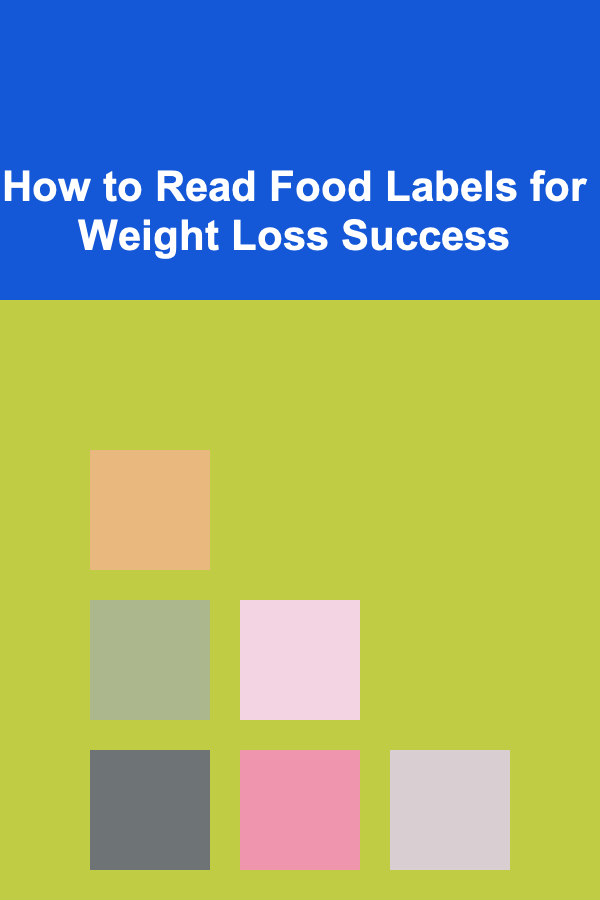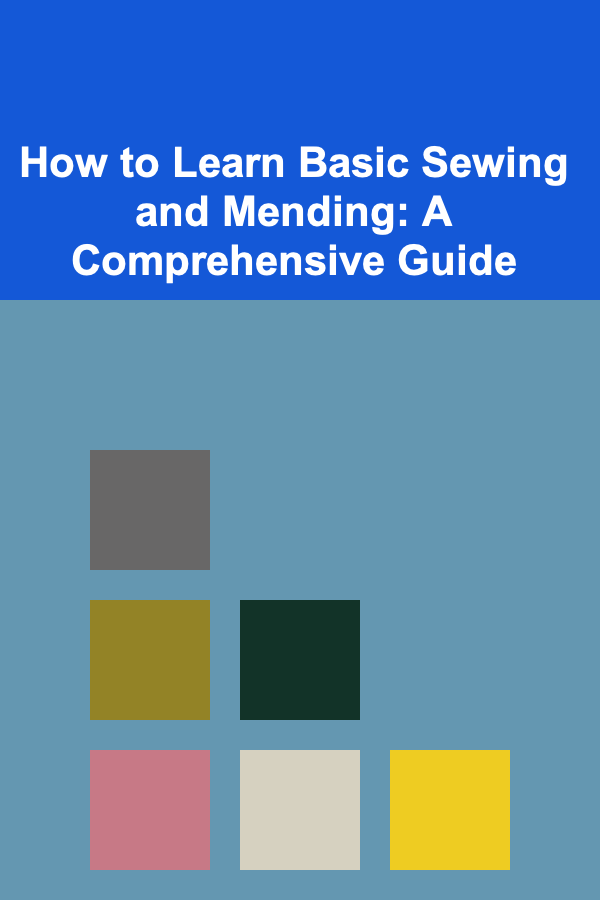
How to Read Food Labels for Weight Loss Success
ebook include PDF & Audio bundle (Micro Guide)
$12.99$9.99
Limited Time Offer! Order within the next:

When embarking on a weight loss journey, understanding what you eat is crucial. It's not just about counting calories but about choosing foods that nourish your body while helping you shed excess weight. One of the most effective tools in this process is food labels. They provide essential information that can help you make informed decisions, avoid hidden sugars, unhealthy fats, and excess calories, and ultimately steer you toward healthier food choices. In this article, we'll break down how to read food labels for weight loss success, offering tips and strategies to use these labels as a powerful ally in your diet.
Understanding the Basics of Food Labels
Food labels are designed to inform consumers about the nutritional content of a product. These labels can vary slightly between countries, but the main components are generally the same. In the United States, for example, the Food and Drug Administration (FDA) requires manufacturers to include the following elements on the label:
- Serving size
- Calories per serving
- Macronutrient breakdown (fats, carbohydrates, protein)
- Micronutrients (vitamins and minerals)
- Ingredient list
- Percent daily values (DV) for various nutrients
Let's break each of these components down in detail and explore how they can help you make better food choices for weight loss.
Serving Size
The first piece of information you will encounter on a food label is the serving size. It's critical to note that serving sizes are often smaller than what people typically consume. For example, the serving size for a bag of chips may be listed as 10 chips, but you might easily consume 30 or more. This discrepancy can be a major factor in overeating.
Why Serving Size Matters
When you look at the serving size, you are essentially looking at the nutritional content for that portion. So if the serving size is 1 cup, and you eat 2 cups, you're doubling the calories, fat, and carbs listed on the label. To be accurate in your calorie tracking for weight loss, make sure you measure your portions based on the serving size, not just your instinct or what you feel like eating.
Tip:
Use a food scale or measuring cups to ensure that your servings match the label's recommendations. This simple step can help you prevent overeating and stay within your caloric limits.
Calories per Serving
Calories are the most direct measure of how much energy a food provides. To lose weight, you need to consume fewer calories than your body burns. This concept is often referred to as creating a caloric deficit. However, simply cutting calories isn't enough; the quality of the calories matters as well.
Why Calories Matter
Each food label will show how many calories are in a single serving. If you're trying to lose weight, this is a key figure to monitor. However, don't just look at the calorie count---look at the quality of those calories. Whole, unprocessed foods like fruits, vegetables, lean proteins, and whole grains tend to provide more nutrition per calorie than processed foods filled with empty calories.
Tip:
For weight loss, aim to consume nutrient-dense, low-calorie foods that will fill you up and provide your body with essential nutrients, rather than opting for foods that are high in calories but low in nutritional value, like sugary snacks or fried foods.
Macronutrients Breakdown: Fats, Carbs, and Protein
After calories, the next important information you'll see on a food label is the macronutrient breakdown . This includes fats , carbohydrates , and protein. Understanding how to balance these macronutrients is crucial for successful weight loss.
Fats: Understanding the Types of Fat
Fats are essential for the body, but not all fats are created equal. The label will typically break down the total fat content into saturated fat , unsaturated fat , and sometimes trans fat.
- Saturated fats (found in animal products and processed foods) should be limited, as they can contribute to increased cholesterol and weight gain.
- Unsaturated fats (found in nuts, seeds, avocados, and olive oil) are healthy fats that can help reduce inflammation and improve heart health.
- Trans fats are the worst kind of fats and should be avoided altogether. They are found in many processed and packaged foods.
Carbohydrates: Simple vs. Complex Carbs
Carbohydrates are the body's primary energy source, but they can also contribute to weight gain when consumed in excess, particularly refined carbohydrates like sugar and white bread. The label will show the total carbohydrates, including fiber and sugars.
- Fiber is a carbohydrate that doesn't get digested by the body but is important for digestive health and keeping you feeling full longer.
- Sugars on the label include both naturally occurring sugars (like those in fruit) and added sugars (like those in sodas and candies). Added sugars can contribute to excess calorie intake and are linked to obesity, diabetes, and other health problems.
Protein: Building Blocks of the Body
Protein is essential for muscle repair and growth, and it helps you feel full and satisfied. A high-protein diet can also help with fat loss by preserving muscle mass while losing weight. Look for protein-rich foods, such as lean meats, beans, and legumes.
Tip:
For weight loss, aim for a diet that includes a healthy balance of fats, complex carbohydrates, and high-quality protein. For example, a meal that contains lean protein (chicken or tofu), healthy fats (avocado or olive oil), and complex carbs (whole grains or vegetables) is likely to keep you satisfied longer and provide more nutritional value.
Micronutrients: Vitamins and Minerals
Micronutrients, including vitamins and minerals, are just as important as macronutrients for overall health and wellness, but they don't contribute calories. These nutrients support various bodily functions, including immune health, bone strength, and energy production.
Key Micronutrients for Weight Loss
- Vitamin D: Plays a role in regulating fat storage and metabolism.
- Calcium: Essential for bone health and may help with fat breakdown.
- Magnesium: Supports muscle function and may help control blood sugar levels.
Tip:
While you may not need to track every vitamin and mineral on the food label, focusing on getting a variety of micronutrients from whole foods (such as fruits, vegetables, and lean proteins) can help ensure that you're staying healthy while losing weight.
Ingredient List
The ingredient list tells you what's actually in the food product. The ingredients are listed in order of quantity, so the first few ingredients make up the majority of the product. Pay special attention to these:
- Added sugars: Ingredients like corn syrup, cane sugar, high-fructose corn syrup, and honey are different forms of added sugars that contribute extra calories.
- Unhealthy oils: Oils like partially hydrogenated oils (trans fats) or palm oil can be detrimental to heart health.
- Artificial additives and preservatives: These chemicals may not contribute to weight gain directly but can be signs that the product is heavily processed.
Tip:
When reading ingredient lists, choose products with short, recognizable ingredients. The fewer the ingredients, the less processed the food likely is, and the more nutritious it probably is.
Percent Daily Values (DV)
The Percent Daily Value (DV) on a food label tells you how much of a nutrient is in one serving of the product, based on a daily diet of 2,000 calories. For example, if a product provides 10% DV for fat, that means that one serving of the product contains 10% of your daily recommended fat intake.
Why DV Matters for Weight Loss
The DV can help you understand if a food is a good source of essential nutrients or if it's too high in certain ingredients like fat or sugar. For example, if you're trying to limit your intake of sodium, a product with 20% DV for sodium would be considered high.
Tip:
For weight loss, aim for foods that are low in added sugars and sodium , and high in fiber and protein.
How to Apply Food Label Knowledge to Your Weight Loss Goals
Now that we've broken down the essential components of food labels, the next step is understanding how to use this knowledge in your day-to-day food choices.
- Track Calories and Macronutrients: Start by keeping a food diary or using an app to track your food intake. Pay attention to the calorie content, and macronutrient breakdown, and monitor your portion sizes.
- Prioritize Whole Foods: Focus on whole foods like fruits, vegetables, lean proteins, and whole grains, which are generally lower in calories and more nutrient-dense.
- Limit Processed Foods: Processed foods are often high in added sugars, unhealthy fats, and empty calories. Use food labels to avoid these products.
- Stay Mindful of Serving Sizes: Be conscious of the serving sizes listed on the label. Overeating, even healthy foods, can hinder weight loss efforts.
Conclusion
Understanding how to read food labels is a powerful tool for achieving weight loss success. By focusing on serving sizes, calories, macronutrients, and ingredient lists, you can make smarter, more informed choices. Additionally, by prioritizing whole foods and minimizing processed options, you can nourish your body while losing weight. The next time you're in the grocery store, take a moment to carefully read the labels on the products you're buying. With this knowledge, you'll be well on your way to achieving your weight loss goals.

Developing Interactive Digital Flashcards: An Actionable Guide
Read More
How to Add a Touch of Luxury to Your Renovation on a Budget
Read More
How to Create a Beauty Bar for Luxury Cosmetics
Read More
How to Organize Bookshelves for Aesthetic Appeal
Read More
How to Utilize Online Libraries and Resources Effectively
Read More
How to Learn Basic Sewing and Mending: A Comprehensive Guide
Read MoreOther Products

Developing Interactive Digital Flashcards: An Actionable Guide
Read More
How to Add a Touch of Luxury to Your Renovation on a Budget
Read More
How to Create a Beauty Bar for Luxury Cosmetics
Read More
How to Organize Bookshelves for Aesthetic Appeal
Read More
How to Utilize Online Libraries and Resources Effectively
Read More